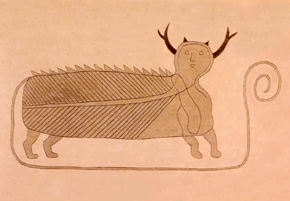GRANVILLE, COLUMBUS
"ALLIGATOR" EFFIGY"
Just outside town to the east is the “Alligator” Effigy, the greatest animal effigy in Ohio after Serpent Mound. Now preserved by the Ohio Historical Society, it is accessible from the old Newark-Granville road: take Broadway heading east, and after about a mile enter the subdivision called “Bryn du Woods” on the left and follow the street as it curves to the left and climbs to the hilltop. The effigy lies atop the cul-de-sac at the end, and is best seen in very early or very late sunlight when the shadows are deep.
The beautiful views (now between large houses) from this hilltop extend westward to open plains beyond Granville, and eastward into the defined valley terraces across which the Newark Earthworks were laid out. The builders of the effigy no doubt appreciated these relationships, the prominence of this spot in encompassing the dual ecologies, and especially the nearby geometric earthworks which were already 800 years old when this effigy was begun.
The earthen creature with four rounded feet and a long, curling tail became known to early settlers as the “alligator” but there are more likely possibilities. It may be the “underwater panther,” a powerful creature of the watery underworld, believed by Indians to have dark and dangerous powers, and a long tail that could unleash canoe-swamping whirlpools. A mysterious fifth appendage was an elevated, stone-covered circle, coming out of the animal’s side, where many fires burned. Barbara Mann, of Seneca heritage, interprets this feature as the womb or pouch of an opossum:
And that womb is very powerful earth medicine. And it is put on top of the highest hill in the area, where you can see all the other mound works in that huge ceremonial area – a very intentional and careful combination of sky and earth; because that hill, that highest hill, that’s sky. That’s absolutely sky. And you’ve got that marsupial on top of it, that’s earth, so you’ve got sky and earth brought together in a very ceremonial way.

The Alligator as drawn by Squier and Davis in 1848, showing the heavily burned “altar” area emerging from the torso.
How would a four legged effigy creature in Ohio, with a curly tail, end up with the improbable name of “Alligator”? Dr. Brad Lepper explains one possibility, based on his research of Indians’ of oral traditions of the “underwater panther”:
We certainly know that Native Americans and European American pioneers lived at the same time in the Granville area. Well, what if one of those pioneers had asked a Native American what that was? And if that Native American used their own term – the Ojibway term is “Mishewayshee,” for Underwater Panther – and the European is still struggling with the language, and it’s like “underwater panther? Panthers don’t live underwater; what do you mean?” And if the Native American had said, “that spirit, that creature that lives in the water with a long tail and sometimes eats people,” the European would have said, “Oh you mean an alligator!”
From the effigy, or from the heart of Granville, there is easy access to the four-lane highway SR 16, leading east into the city of Newark (see Newark page), or west (turning into SR 161) to Columbus.

This drawing of the mythical “Undewater Panther” illustrates its curling tail, also present on the effigy mound.


